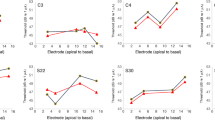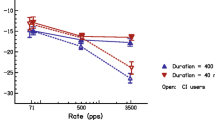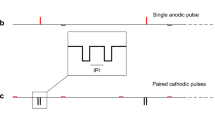Abstract
Most cochlear implants (CIs) activate their electrodes non-simultaneously in order to eliminate electrical field interactions. However, the membrane of auditory nerve fibers needs time to return to its resting state, causing the probability of firing to a pulse to be affected by previous pulses. Here, we provide new evidence on the effect of pulse polarity and current level on these interactions. In experiment 1, detection thresholds and most comfortable levels (MCLs) were measured in CI users for 100-Hz pulse trains consisting of two consecutive biphasic pulses of the same or of opposite polarity. All combinations of polarities were studied: anodic-cathodic-anodic-cathodic (ACAC), CACA, ACCA, and CAAC. Thresholds were lower when the adjacent phases of the two pulses had the same polarity (ACCA and CAAC) than when they were different (ACAC and CACA). Some subjects showed a lower threshold for ACCA than for CAAC while others showed the opposite trend demonstrating that polarity sensitivity at threshold is genuine and subject- or electrode-dependent. In contrast, anodic (CAAC) pulses always showed a lower MCL than cathodic (ACCA) pulses, confirming previous reports. In experiments 2 and 3, the subjects compared the loudness of several pulse trains differing in current level separately for ACCA and CAAC. For 40 % of the electrodes tested, loudness grew non-monotonically as a function of current level for ACCA but never for CAAC. This finding may relate to a conduction block of the action potentials along the fibers induced by a strong hyperpolarization of their central processes. Further analysis showed that the electrodes showing a lower threshold for ACCA than for CAAC were more likely to yield a non-monotonic loudness growth. It is proposed that polarity sensitivity at threshold reflects the local neural health and that anodic asymmetric pulses should preferably be used to convey sound information while avoiding abnormal loudness percepts.










Similar content being viewed by others
References
Bahmer A, Baumann U (2013) Effects of electrical pulse polarity shape on intra cochlear neural responses in humans: triphasic pulses with cathodic second phase. Hear Res 306:123–130
Bierer JA (2010) Probing the electrode-neuron interface with focused cochlear implant stimulation. Trends Amplif 14:84–95
Boulet J, White M, Bruce IC (2016) Temporal considerations for stimulating spiral ganglion neurons with cochlear implants. J Assoc Res Otolaryngol 17:1–17
Carlyon RP, Deeks JM, Macherey O (2013) Polarity effects on place pitch and loudness for three cochlear-implant designs and at different cochlear sites. J Acoust Soc Am 134:503–509
Cosentino S, Carlyon RP, Deeks JM, Parkinson W, Bierer JA (2016) Rate discrimination, gap detection and ranking of temporal pitch in cochlear implant users. J Assoc Res Otolaryngol 17:371–382
de Balthasar C, Boëx C, Cosendai G, Valentini G, Sigrist A, Pelizzone M (2003) Channel interactions with high-rate biphasic electrical stimulation in cochlear implant subjects. Hear Res 182:77–87
Eddington DK, Noel VA, Rabinowitz WM, Svirsky MA, Tierney J, Zissman MA (1994) Speech processors for auditory prostheses. Eighth quarterly progress report, NIH Contract N01-DC-2-2402.
Favre E, Pelizzone M (1993) Channel interactions in patients using the Ineraid multichannel cochlear implant. Hear Res 66:150–156
Frijns JH, de Snoo SL, ten Kate JH (1996) Spatial selectivity in a rotationally symmetric model of the electrically stimulated cochlea. Hear Res 95:33–48
Hartmann R, Topp G, Klinke R (1984) Discharge patterns of cat primary auditory fibers with electrical stimulation of the cochlea. Hear Res 13:47–62
Karg SA, Lackner C, Hemmert W (2013) Temporal interaction in electrical hearing elucidates auditory nerve dynamics in humans. Hear Res 299:10–18
Khan AM, Handzel O, Burgess BJ, Damian D, Eddington DK, Nadol JB Jr (2005) Is word recognition correlated with the number of surviving spiral ganglion cells and electrode insertion depth in human subjects with cochlear implants? Laryngoscope 115:672–677
Laneau J, Boets B, Moonen M, van Wieringen A, Wouters J (2005) A flexible research auditory platform using acoustic or electric stimuli for adults and young children. J Neurosci Methods 142:131–136
Long CJ, Nimmo-Smith I, Baguley DM, O’Driscoll M, Ramsden R, Otto SR, Axon PR, Carlyon RP (2005) Optimizing the clinical fit of auditory brain stem implants. Ear Hear 26:251–262
Macherey O, van Wieringen A, Carlyon RP, Deeks JM, Wouters J (2006) Asymmetric pulses in cochlear implants: effects of pulse shape, polarity and rate. J Assoc Res Otolaryngol 7:253–266
Macherey O, Carlyon RP, van Wieringen A, Wouters J (2007) A dual-process integrator-resonator model of the electrically stimulated human auditory nerve. J Assoc Res Otolaryngol 8:84–104
Macherey O, Carlyon RP, van Wieringen A, Deeks JM, Wouters J (2008) Higher sensitivity of human auditory nerve fibers to positive electrical currents. J Assoc Res Otolaryngol 9:241–251
Macherey O, Carlyon R (2014) Re-examining the upper limit of temporal pitch. J Acoust Soc Am 136:3186–3199
Macherey O, Cazals Y (2016) Effects of pulse shape and polarity on sensitivity to cochlear implant stimulation: a chronic study in guinea pigs. Adv Exp Med Biol 894:133–142
Middlebrooks JC (2004) Effects of cochlear-implant pulse rate and inter-channel timing on channel interactions and thresholds. J Acoust Soc Am 116:452–468
Miller CA, Abbas PJ, Rubinstein JT, Robinson BK, Matsuoka AJ, Woodworth G (1998) Electrically evoked compound action potentials of guinea pig and cat: responses to monopolar, monophasic stimulation. Hear Res 119:142–154
Moon AK, Zwolan TA, Pfingst BE (1993) Effects of phase duration on detection of electrical stimulation of the human cochlea. Hear Res 67:166–178
Morsnowski A, Charasse B, Collet L, Killian M, Müller-Deile J (2006) Measuring the refractoriness of the electrically stimulated auditory nerve. Audiol Neurootol 11:389–402
Nadol JB Jr, Shiao JY, Burgess BJ, Ketten DR, Eddington DK, Gantz BJ, Kos I, Montandon P, Coker NJ, Roland JT Jr, Shallop JK (2001) Histopathology of cochlear implants in humans. Ann Otol Rhinol Laryngol 110:883–891
Nelson DA, Donaldson GS (2001) Psychophysical recovery from single-pulse forward masking in electric hearing. J Acoust Soc Am 109:2921–2933
Ranck JB Jr (1975) Which elements are excited in electrical stimulation of mammalian central nervous system: a review. Brain Res 98:417–440
Rattay F (1999) The basic mechanism for the electrical stimulation of the nervous system. Neuroscience 89:335–346
Rasbah J, Steele F, Browne W, Goldstein H (2009) A user’s guide to MLwiN, version 2.10. Centre for Multilevel Modelling, University of Bristol, Bristol, UK.
Rattay F, Lutter P, Felix H (2001) A model of the electrically excited human cochlear neuron. I. Contribution of neural substructures to the generation and propagation of spikes. Hear Res 153:43–63
Rubinstein JT (1993) Axon termination conditions for electrical stimulation. IEEE Trans Biomed Eng 40:654–663
Wilson BS, Finley CC, Lawson DT, Wolford RD, Eddington DK, Rabinowitz WM (1991) Better speech recognition with cochlear implants. Nature 352:236–238
Acknowledgements
This project was supported by a grant from the Agence Nationale de la Recherche (Grant No. ANR-11-PDOC-0022) and a collaborative grant between Marseille and Cambridge funded by the CNRS (PICS). Author RPC is funded by the UK Medical Research Council programme MC-A060-5PQ70. We thank Gaston Hilkhuysen for his help on the linear mixed-effects modeling and for the helpful comments on a previous version of this manuscript.
Author information
Authors and Affiliations
Corresponding author
Rights and permissions
About this article
Cite this article
Macherey, O., Carlyon, R.P., Chatron, J. et al. Effect of Pulse Polarity on Thresholds and on Non-monotonic Loudness Growth in Cochlear Implant Users. JARO 18, 513–527 (2017). https://doi.org/10.1007/s10162-016-0614-4
Received:
Accepted:
Published:
Issue Date:
DOI: https://doi.org/10.1007/s10162-016-0614-4




